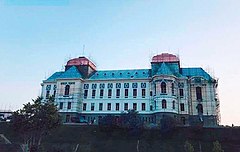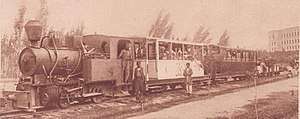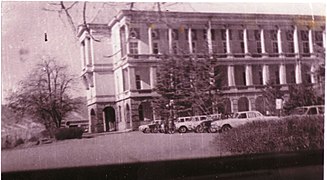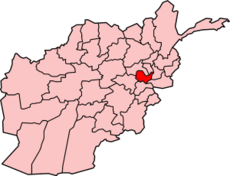Darul Aman Palace
Darul Aman Palace (Persian: قصر دارالامان; Pashto: د دارالامان ماڼۍ; "abode of peace" or, in a double meaning "abode of Aman[ullah]")[1] is a palace located about 16 kilometres (9.9 mi) south-west outside of the center of Kabul, Afghanistan. It sits directly across from the Afghan Parliament, and is close to the National Museum of Afghanistan and the American University of Afghanistan.
| Darul Aman Palace | |
|---|---|
قصر دارالامان - د دارالامان ماڼۍ | |
 Darul Aman Palace in 2019 during restoration | |

| |
| General information | |
| Status | Reconstructed in 2019 on the 100th Independence Day of Afghanistan |
| Type | Palace |
| Architectural style | Neoclassical |
| Town or city | Kabul |
| Country | Afghanistan |
| Construction started | 1925 |
| Completed | 1927 |
| Inaugurated | 19 August 2019 (renovation) |
| Renovated | 2016-2019 |
| Renovation cost | $20 million |
| Height | 107 ft (33 m) |
| Technical details | |
| Material | Brick Marble (spiral staircases) |
| Floor count | 3 |
| Design and construction | |
| Architect | Walter Harden A. Godard M. Godard |
| Other information | |
| Number of rooms | 150 |
In 2019, the palace was fully renovated for the 100th year of Afghan Independence, which was on the 19th of August, 2019.[2][3]
History
Construction of the Darul Aman Palace began in the early 1920s as a part of the endeavours of King Amanullah Khan to modernize Afghanistan. It was to be part of the new capital city called Darulaman, connected to Kabul by a narrow gauge railway.[4] Amanullah Khan invited 22 architects from Germany and France to build the palace.[5] The palace is considered to be a testimony of the Afghan-German ties, as it was designed by German engineer Walter Harten and his team of engineers.[6]
The palace is an imposing neoclassical building on a hilltop overlooking a flat, dusty valley in the western part of the Afghan capital. Designed by French architects A. Godard and M. Gordad, as well as German architects, it was one of the first buildings in the country to get central heating and running water.[3][7] Intended as the seat of a future parliament, the building remained unused and partially complete for many years after religious conservatives under Habibullah Kalakani forced Amanullah from power in 1929, and halted his reforms. In later years it served as the medical school for Kabul University, as well a warehouse, and the seat of several smaller ministries.[3]
The building was gutted by fire on 14 December 1968, and afterwards restored to house the Ministry of Defense during the 1970s and 1980s. In the Communist coup of 1978, the building was once more set on fire. Much of the building was damaged by tank fire during Shahnawaz Tanai's failed coup attempt on 6 March 1990.[8] It was once again damaged in the 1990s as rival Mujahideen factions fought for control of Kabul. Heavy shelling by the Mujahideen left the palace a gutted ruin, including the garage containing the vehicles of the former king which were removed and used as target practice, all ultimately being destroyed. It was mostly used as a refugee settlement and a nomad camp until the early 2000s, when it became a battalion headquarters for the Afghan National Army.[3]


In 2005, a plan was unveiled to refurbish the palace for use as the seat of Afghanistan's future parliament.[9] It was to be funded primarily by private donations from foreigners and wealthy Afghans. The palace one of several targets in a series of attacks launched on 15 April 2012, for which the Taliban claimed responsibility.[10] Eventually it was decided to develop a new building opposite the palace to house the parliament under a grant, provided by India. Construction was completed in 2015.
In early 2016, work began on a $20 million restoration project, intended to renovate the palace in time for the centenary of Afghanistan's full independence in 1919. Nearly 600 tons of debris was initially removed from the 150-room building and by the spring of 2017, workers were taking down plaster and concrete from the inner walls.[3] Over 80 engineers and architects were involved in the project, of which 25 percent were female. It was announced in February 2018, that almost 50 percent of the renovation was complete and then was completed in full by July 2019.[11]
On 18 April 2020, an opening ceremony was held as the palace was converted into a COVID-19 isolation and treatment center with 200 beds during the COVID-19 pandemic in Afghanistan.[12][13]
Architecture
The palace is a U-shaped brick building, built in a European neoclassical style. It has 3 floors with 150 rooms, including a semi-circular main hall. Its highest point is around 33 m (108 ft) above ground level. There are four domed towers on the roof. The galleries on the third floor of the southern facade are decorated with a number of Corinthian columns. Each floor is connected by marble spiral staircases.[14][15][16]
In pop culture
In the 2015 game Metal Gear Solid V: The Phantom Pain (which is set in Kabul), there's a location called Lamar Khaate Palace that is clearly inspired by Darul Aman palace.
Gallery
 The southern facade in 2002
The southern facade in 2002 Palace in 1986
Palace in 1986- Northern elevation showing shelling damage inflicted during mujahideen fighting for Kabul after Soviet withdrawal
 Heavy snowfall at the palace
Heavy snowfall at the palace The palace in 1982, with Soviet Army trucks visible
The palace in 1982, with Soviet Army trucks visible- Western elevation
- 2 US Special Forces soldiers view Kabul looking north
- US Commandos patrolling a heavily bombed out room in the palace in 2002
 The inside of the palace is in very bad shape in July 2010
The inside of the palace is in very bad shape in July 2010 View from the Afghan Parliament building showing the ruins of the palace, under reconstruction in December 2015
View from the Afghan Parliament building showing the ruins of the palace, under reconstruction in December 2015
See also
- National Assembly of Afghanistan, the parliament of Afghanistan located opposite the Darul Aman Palace, and completed in December 2015.
- Tajbeg Palace, located on a nearby hill and built as a residence for Amanullah, his wife, Queen Soraya, and their family.
- Bagh-e Bala Palace, a palace built as a leisure home for Abdur Rahman Khan in 1893
References
- Clements, Frank (2003) Conflict in Afghanistan, a Historical Encyclopaedia. ABC-CLIO, Santa Barbara, ISBN 1-85109-402-4, page 29, 67.
- Reconstruction of the Palace of the Darulaman on YouTube, Jan. 5, 2019, National Defense and Operations Directorate chaired by JHA
- "Saving an Afghan Symbol, With Afghans Only". The New York Times. 2017-04-05. Retrieved 2017-04-06.
- "Kabul to Darulaman railway". Sndrewgrantham.co.uk. Retrieved 2016-02-24.
- "Cabinet Approves Darul Aman Palace Reconstruction Budget". Sada-E-Azadi. 12 March 2016. Archived from the original on 2018-02-08. Retrieved 2019-03-16.
- Azadi, Sada-e. "Cabinet Approves Darul Aman Palace Reconstruction Budget". www.sada-e-azadi.net. Archived from the original on 2018-02-08. Retrieved 2018-02-07.
- "Art Of War - Военно-исторический литературный портал". 2018-07-29. Archived from the original on 2018-07-29. Retrieved 2020-05-16.
- Ghani, Mariam & Ashraf (8 September 2012). "Palace of Abandoned Dreams".
- "Place to see: Darul Aman Palace, Kabul, Afghanistan". Archived from the original on December 21, 2009. Retrieved February 1, 2010.
- "Taliban strike across Afghanistan in 'spring offensive'". BBC News. 16 April 2012.
- "Renovation of Darul Aman Palace To Resume In Spring - TOLOnews".
- "Afghanistan turns iconic palace into isolation facility". www.aa.com.tr. Retrieved 2020-05-16.
- "COVID-19 Cases Reach 933 in Afghanistan". TOLOnews. Retrieved 2020-05-16.
- "In pictures: Kabul's battle-scarred palace". BBC News. 2014-11-09. Retrieved 2020-05-16.
- Nordland, Rod (2017-04-05). "Saving an Afghan Symbol, With Afghans Only". The New York Times. ISSN 0362-4331. Retrieved 2020-05-16.
- Mumtaz, Babar; Noschis, Kaj (2004). Development of Kabul: Reconstruction and planning issues. pp. 154–172. ISBN 2-940075-09-3.
External links
| Wikimedia Commons has media related to Darul-Aman Palace. |
- Darul-Aman Project for Kabul
- The story of the german ingenieur Wilhelm Rieck. Lots of historical pictures
- The Shattered Remains of Afghanistan’s Versailles
- Reconstruction of the Palace of the Darulaman on YouTube, Jan. 5, 2019, National Defense and Operations Directorate chaired by JHA
- In restoring a century-old palace, a step toward rebuilding Afghanistan's independence on YouTube, Sep. 12, 2016 PBS NewsHour
